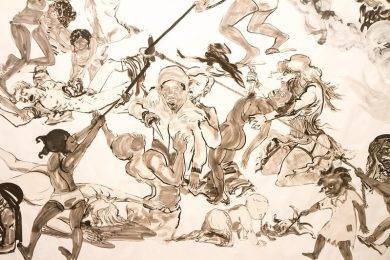“Modern” and “contemporary” are commonly used interchangeably to more or less mean the same thing, but in art, they have a defined difference.
The modern art contemporary art difference lies mainly in the time frame in which the art was produced, with modern art coming before contemporary art. Many art critics and historians pin modern art as having begun in the 1860s and continued up until the 1960s or 1970s. Contemporary art, on the other hand, is art that is made during the present day, from the 1960s onward.
The time period is not the only issue that defines these two types of art. Much of the art produced since the 1960s has been sociopolitical in nature, whereas art beforehand was not always as such. For example, Kara Walker is one of the many contemporary artists who present their political views through art. 40 Acres of Mules (Kara Walker), with its challenging imagery and striking size, is a momentous artwork that condemns racism in America.
All of the differences between contemporary and modern art do not mean that they are without their similarities, however. Each era of art was also considered revolutionary in its own right. Over the last 200 years, there has been more of a change in art than there was in any other time in history. Artists from both eras tried to experiment and be revolutionary, but modern art was what truly brought down the wall for contemporary artists to have full range and freedom over their artistic expression.
It is difficult to find a modernist artist who is living today, though there are a few. Though some art historians put a start date on contemporary art somewhere in the 1960s, contemporary art can be used to describe art after World War II in 1945. This means there are some living artists who, during the modernist era, created modern art. One example of this is David Hockney, a man who is now in his 80s. He worked within the pop art movement in the 1960s but is still creating art to this day. This makes him both a contemporary and a modern artist with his body of work resting on the line of both of these categories.
Contemporary art, in its simplest sense, refers to art, especially photography, painting, sculpture, installation art, video art and performance art, that is produced today. It is evolving continuously with artists using technology to their advantage for expressing their ideas. Code-generated art is one of the best examples of this, as code can be used to produce everything from futuristic portraits to abstract art. The impact of NFTs on the art world has also been profound. Contemporary artists are not only using the digital mediums powered by NFTs to create novel art, but also finding new ways to express social issues.
Modern and contemporary art are not at all the same. These two distinct eras span over two centuries of time, wherein art went through more shifts than it has in any other period in history. It is this shift in style and the many new forms that were born of it that marks the difference between modern and contemporary art, and art as we once knew it.
Photo Credit: “Kara Walker, The Pool Party of Sardanapalus (after Delacroix, Kienholz)” by gsz.
I am Jones Smith and I am here to share my experience and expertise in writing. I’ve been writing articles for different publications for more than 6 years. I have a varied range of interests and that’s why I love blogging about different topics. In my opinion, blogging is a lot like acting, and I consider writing blog posts as an acting job. I am an entrepreneur by heart and there is nothing big or small when it comes to starting a business.











